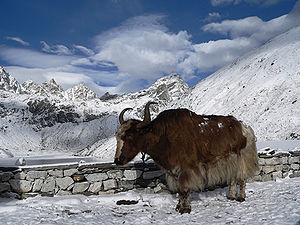Animals of Tibet's Chang Tang
The wildlife on the upper roof of the world.
Yak
The yak (Bos grunniens) (Tibetan: གཡག་; Wylie: g.yag) is a long-haired bovine found throughout the Himalayanregion of south Central Asia, the Tibetan Plateau and as far north as Mongolia. In addition to a large domestic population, there is a small, vulnerable wild yak population. In Tibetan, the word gyag refers only to the male of the species; a female is a dri or nak. In most languages which borrowed the word, including English, yak is usually used for both sexes.
Yaks belong to the genus Bos, and are, therefore, closely related to cattle, with whom they commonly interbreed, as well as the Southeast Asian banteng, gaur or Indian Bison, and the now extremely rarekouprey.
Yaks are herd animals. Wild male yaks stand about 2 to 2.2 metres (6.6 to 7.2 ft) tall at the shoulder and average 1,000 kg (2,200 lb); the females weigh about one third of this.[2] domesticated yaks are much smaller, males weighing 350 to 580 kg (770 to 1,300 lb) and females 225 to 255 kg (500 to 560 lb).[3] Both sexes have long shaggy hair to insulate them from the cold. Wild yaks can be brown or black. Domesticated ones can also be white. Both males and females have horns.
Domestic yaks mate in about September; the females may first conceive at about 3–4 years of age, calving April to June about every other or every third year, apparently depending upon food supply. This gestation period is approximately 9 months. In the absence of more data, wild animals are assumed to mirror this reproductive behavior. Calves will be weaned at one year and become independent shortly thereafter. Yaks may live to somewhat more than 20 years.
